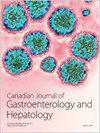Prevalence of Esophageal Eosinophilia, Eosinophilic Esophagitis, and Lymphocytic Gastritis in Children with Celiac Disease: A Saudi Tertiary Center Experience
IF 2.3
4区 医学
Q2 Medicine
引用次数: 0
Abstract
Background. Celiac disease (CD) is an immune-mediated enteropathy that has been associated with other immune-related gastrointestinal disorders, such as eosinophilic esophagitis (EoE) and lymphocytic gastritis (LG). To our knowledge, this is the first study in Saudi Arabia that has described such an association. Aim. To evaluate the prevalence of EoE and LG in children and adolescents with CD. Methods. This was a retrospective cross-sectional study of all pediatric patients (aged 0–18 years) with CD following up at King Abdulaziz University Hospital, between January, 2014, and December, 2021. The study examined clinical, demographic, endoscopic, and histopathological data. Results. Seventy-five patients with CD were included in the analysis. The median age was 12 years (range, 2–18 years). Male constituted 54.7% of the overall cohort (n = 41). The most common clinical symptoms were short stature (54.7%), weight loss (34.7%), abdominal pain (33.3%), abdominal distension (29.3%), anorexia (29.3%), diarrhea (24%), and vomiting (21.3%). The esophageal biopsy results reported were basal cell hyperplasia in 24 patients (32.9%), esophageal eosinophilia in 23 patients (31.5%), and EoE in 3 patients (4.1%). The gastric biopsy results were normal in 40 patients (53.3%). The most common abnormality was chronic inactive gastritis with no Helicobacter pylori (HP) infection (16%). LG was found in 3 patients (4%). Conclusions. The prevalence of EoE in this cohort of patients with CD was lower than the prevalence recorded in a number of other studies. Further studies are needed to determine the effects of a gluten-free diet (GFD) on EOE and LG.乳糜泻患儿食管嗜酸性粒细胞增多症、嗜酸性粒细胞性食管炎和淋巴细胞性胃炎的患病率:沙特三级医疗中心的经验
背景。乳糜泻(CD)是一种免疫介导的肠病,与其他免疫相关的胃肠道疾病,如嗜酸性粒细胞食管炎(EoE)和淋巴细胞性胃炎(LG)有关联。据我们所知,这是沙特阿拉伯第一项描述这种关联的研究。研究目的评估 CD 儿童和青少年中 EoE 和 LG 的发病率。方法。这是一项回顾性横断面研究,研究对象是 2014 年 1 月至 2021 年 12 月期间在阿卜杜勒阿齐兹国王大学医院就诊的所有 CD 儿童患者(0-18 岁)。研究考察了临床、人口统计学、内窥镜和组织病理学数据。研究结果75名 CD 患者纳入分析。中位年龄为 12 岁(2-18 岁)。男性占总人数的 54.7%(n = 41)。最常见的临床症状是身材矮小(54.7%)、体重减轻(34.7%)、腹痛(33.3%)、腹胀(29.3%)、厌食(29.3%)、腹泻(24%)和呕吐(21.3%)。食管活检结果显示,24 名患者(32.9%)出现基底细胞增生,23 名患者(31.5%)出现食管嗜酸性粒细胞增多,3 名患者(4.1%)出现 EoE。40名患者(53.3%)的胃活检结果正常。最常见的异常是没有幽门螺旋杆菌(HP)感染的慢性非活动性胃炎(16%)。有 3 名患者(4%)发现了 LG。结论。本组 CD 患者的胃食管反流患病率低于其他一些研究记录的患病率。需要进一步研究确定无麸质饮食(GFD)对肠易激综合征和 LG 的影响。
本文章由计算机程序翻译,如有差异,请以英文原文为准。
求助全文
约1分钟内获得全文
求助全文
来源期刊

Canadian Journal of Gastroenterology and Hepatology
GASTROENTEROLOGY & HEPATOLOGY-
CiteScore
4.80
自引率
0.00%
发文量
0
审稿时长
37 weeks
期刊介绍:
Canadian Journal of Gastroenterology and Hepatology is a peer-reviewed, open access journal that publishes original research articles, review articles, and clinical studies in all areas of gastroenterology and liver disease - medicine and surgery.
The Canadian Journal of Gastroenterology and Hepatology is sponsored by the Canadian Association of Gastroenterology and the Canadian Association for the Study of the Liver.
 求助内容:
求助内容: 应助结果提醒方式:
应助结果提醒方式:


